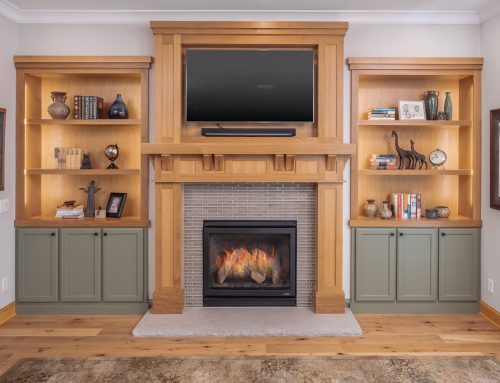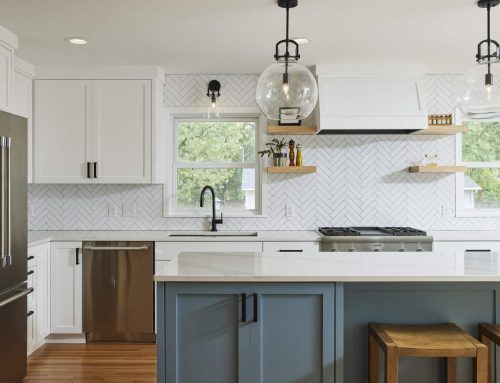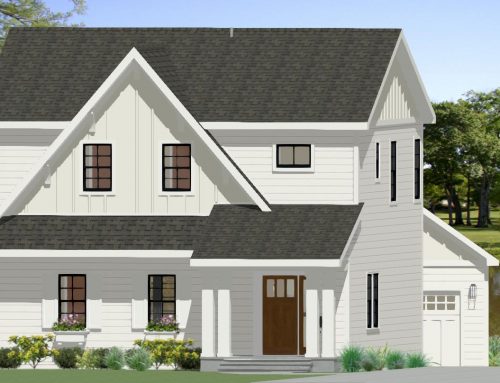A kitchen remodel is more than just a renovation; it’s a reinvention of one of the most essential spaces in your home. Known as the heart of the home, the kitchen is often a central hub of activity, from early-morning breakfasts to late-night chats. Therefore, remodeling this space can significantly improve your home’s functionality, aesthetics, and overall value. A well-planned kitchen remodel can provide a higher return on investment compared to other home improvement projects. It can modernize your space, provide better energy efficiency, and adapt to your evolving needs, making your kitchen more enjoyable and comfortable to use.
This article is designed to guide you through the essential steps in planning a kitchen remodel, ensuring a smooth and successful transformation. We’ll cover everything from initial brainstorming and budgeting to selecting the right materials, appliances, and layout. You’ll gain valuable insights on how to avoid common pitfalls, make smart design choices, and work with professionals to bring your vision to life. So whether you’re planning a simple refresh or a full-scale renovation, this comprehensive guide will offer practical tips and expert advice to help you navigate the remodeling process with ease.
Step 1: Evaluate Your Current Kitchen
Embarking on the journey of kitchen remodeling starts with a crucial first step: evaluating your current kitchen. While it may seem simple enough, this step involves critical thinking and a keen eye for detail. It’s about identifying what works and what doesn’t in your current kitchen. Are your countertops still functional, or are they scratched and stained beyond repair? Is your cabinetry outdated or does it still match your aesthetic taste? By answering such questions, you will be better placed to understand what needs to stay, what needs a facelift, and what has to go.
Consider Your Kitchen’s Current Layout
Next, take a moment to consider your kitchen’s current layout. Layout significantly affects the functionality of your kitchen space. Consider whether your kitchen layout suits your cooking needs or if it hampers your movement. For instance, if you often find yourself bumping into furniture or appliances while cooking or moving about, this might indicate a need for a layout change.
Understanding Your Kitchen’s Traffic Patterns
Understanding your kitchen’s traffic patterns is another crucial aspect of evaluation. If your kitchen serves as a social hotspot where family and friends gather, its traffic pattern needs to accommodate this. Observe the paths you and others most frequently take in your kitchen. If these paths cross your cooking area and cause disruptions, it might be time to consider a layout that offers a smoother, more streamlined traffic flow.
Assess the Condition of Your Current Kitchen Appliances
Lastly, it’s vital to assess the condition of your current kitchen appliances. Consider their efficiency, functionality, and how well they fit in with your desired kitchen style. If your appliances are outdated or energy-draining, replacing them with modern, energy-efficient models will not only improve functionality but also add to the overall value of your home.
Step 2: Set a Budget
Considering Your Financial Situation
Moving on to the second essential step, setting a budget is of paramount importance in planning your kitchen remodel. This process involves determining how much you are willing to spend on the entire project. Start by carefully considering your financial situation and make a realistic assessment of what you can afford. It’s advisable to take into account your savings, monthly income, and other expenses to prevent financial strain during the remodeling process.
Understanding the Cost of Kitchen Remodeling
Understanding the cost of kitchen remodeling is another crucial aspect when setting your budget. Prices can vary dramatically depending on the complexity of the remodel, materials used, and labor costs in your area. Researching these costs and getting quotes from various contractors can help you get a ballpark figure of what to expect. Always ensure you allocate a portion of your budget for unexpected costs. No matter how well you plan, unforeseen expenses can arise during the remodeling process. This could be in the form of plumbing issues, electrical faults, or structural problems that were not evident during the initial assessment. Having a contingency fund gives you peace of mind and ensures the project doesn’t stall due to lack of funds.
Include a Consideration for Quality Versus Quantity
Lastly, the budgeting process should include a consideration for quality versus quantity. While it may be tempting to opt for cheaper materials or labor to save costs, it’s essential to remember that quality often equals durability. Investing in high-quality materials and skilled labor may cost more upfront but can save you money in the long run by reducing the need for repairs or replacements.
Remember, the goal is not just to create a visually appealing kitchen but also one that is functional and will stand the test of time.
Step 3: Find Inspiration
Explore Various Kitchen Remodeling Ideas
After setting a well-planned budget, the next step in planning a kitchen remodel is finding inspiration. With an open mind and a clear sense of your budget limits, you can now explore various kitchen remodeling ideas. The internet is a treasure trove of inspiration. You can find numerous websites, blogs, and social media pages dedicated to home improvement and kitchen remodeling. These platforms provide a myriad of ideas, from simple budget-friendly upgrades to extravagant luxury remodels. Take advantage of these resources to gather ideas and identify what appeals to you most.
Visiting Physical Showrooms
Visiting physical showrooms is an equally beneficial way to gather inspiration. Showrooms allow you to see and interact with different kitchen designs, layouts, and appliances all in one place. You can feel the textures, see how the colors interact with different lighting, and get a sense of the space. This firsthand experience can help you determine what you like and dislike, providing a clearer picture of what your remodeled kitchen could look like.
Considering the Latest Kitchen Design Trends
Lastly, considering the latest kitchen design trends can also offer great insights. Trends reflect what is currently popular and can provide fresh, modern ideas for your kitchen remodel. However, it’s important to balance trendy designs with timeless elements to ensure your kitchen doesn’t appear outdated in a few years.
Remember, the goal is to create a kitchen that reflects your style while also adding value to your home. Keep your budget in mind as you draw inspiration and start to envision your dream kitchen.
Step 4: Design Your Dream Kitchen
After finding inspiration and gathering ideas in the previous step, you’re now ready to delve into the fourth and perhaps the most exciting step of your kitchen remodel: Designing your dream kitchen. This step is where you take charge and start making the bigger decisions about the layout, color scheme, and materials you want to use.
Carefully Consider the Kitchen Layout
First, carefully consider the kitchen layout. Your kitchen must suit your lifestyle and cater to your needs. For instance, you might need a large workspace if you love cooking, or a spacious dining area if you often host dinners. A good layout will ensure that the kitchen is functional and efficient, which is why this decision should be made after careful thought.
Color Scheme
Next, think about the color scheme. The colors you choose can dramatically influence the mood and feel of your kitchen. Light colors can make a small kitchen seem larger, while darker colors can add an element of coziness. You might want to choose a neutral color scheme if you prefer a more timeless look, or a bold color scheme if you’re looking for something more contemporary. Remember to choose colors that align with your style and complement the overall aesthetic of your home.
Reflect a Balance of Style and Functionality
When it comes to selecting your cabinets, countertops, and flooring, your choices should reflect a balance of style and functionality. You might want to choose durable materials that can withstand heavy use, especially if you spend a lot of time cooking in your kitchen. Wood cabinets, granite countertops, and hardwood flooring are popular choices because they are both stylish and durable.
Choose Your Kitchen Appliances
Lastly, choose your kitchen appliances. These should match the style of your kitchen, whether that’s modern, traditional, or something in between. Stainless steel appliances are a safe bet as they look sleek and fit in with most kitchen designs. But the most important consideration should be the functionality and efficiency of the appliances.
Remember, your dream kitchen combines style, function, and personal preferences. So take your time in this step, make informed decisions, and don’t be afraid to consult with a professional if you need to.
Step 5: Hire Professionals
After completing the design phase, the next step in planning a kitchen remodel is hiring professionals to actualize your dream kitchen. The importance of hiring a professional in the kitchen remodeling process cannot be overstated. It’s not just about having the work done, it’s about having the work done right. With the complexity of kitchen remodeling, including plumbing, electrical, and structural works, it’s vital to have experienced professionals handle the job to avoid costly mistakes and ensure the project runs smoothly.
Proven Track Record in Kitchen Remodeling
Finding a reputable kitchen remodeling contractor is crucial in this step. But how do you identify the right one? First, look for a contractor with a proven track record in kitchen remodeling. They should have a portfolio showcasing their previous work and positive reviews from past clients. This provides a glimpse into their work quality and reliability.
Licensed and Insured Contractor
Additionally, ensure that the contractor is licensed and insured. This protects you from any liabilities should anything go wrong during the project. The contractor should also offer a warranty for their work, giving you peace of mind that any post-project issues will be handled.
Communication
Lastly, communication is key. Your contractor should be responsive and willing to answer all your questions. They should also be able to understand and interpret your vision accurately. A contractor who listens and communicates effectively ensures that your expectations and their deliverables align.
Remember, the right contractor not only brings your dream kitchen to life but also guarantees a stress-free remodeling experience. For a kitchen renovation contractor that meets the mentioned criteria, contact Sicora Design/Build.
Step 6: Prepare for the Remodel
Step 6 in planning a kitchen remodel involves preparing for the actual remodeling process. This phase is a crucial one as it ensures a smooth transition and minimizes the inconvenience caused during the construction period.
Creating a Temporary Kitchen Space
One of the key preparations to make is creating a temporary kitchen space. This is because your main kitchen will be out of commission for the duration of the remodel. Set up a temporary space in a convenient area like the dining room or basement with essential appliances like a microwave, toaster, and a small fridge. This will allow you to continue with your normal cooking routines even as work progresses in your main kitchen.
Pack up Your Kitchen
Next, you will need to pack up your kitchen. This involves emptying your cabinets, countertops, and kitchen drawers. It’s an excellent opportunity to declutter and get rid of items you no longer need. Consider using this time to organize your kitchen items and label boxes for easy unpacking once the remodel is complete. Make sure to pack away any breakables or valuables to protect them from potential damage during the construction process.
Prepare Your Home for the Construction
Finally, you’ll need to prepare your home for the construction. This can involve a range of tasks from setting up dust barriers to relocating furniture and other household items. Depending on the extent of your remodel, you may need to consider temporary accommodation to shield yourself from the noise and dust.
Remember that communication with your contractor is vital at this stage. Ensure that they are aware of your living arrangements, and establish a clear plan for how the work will progress.
Step 7: The Remodeling Process
Step 7 in your kitchen remodeling journey is the actual remodeling process. This is the stage where all your careful planning and organizing comes to life. However, knowing what to expect during this phase can help you manage your expectations and ease potential stress. The remodeling process begins with the demolition of your old kitchen, followed by structural changes, installation of new appliances, cabinetry, and countertops, and finally, the finishing touches like painting and decorating.
Keep in Mind: Delays and Unforeseen Issues are Common
During this process, it’s important to keep in mind that delays and unforeseen issues are common in any construction project. You may encounter unexpected problems such as structural issues, old wiring, or plumbing problems that weren’t evident at the planning stage. It’s essential to remain flexible and patient during this process. Regular communication with your contractor is crucial to address these issues promptly and keep the project on track.
Contingency Plan
Dealing with potential issues and delays in a proactive manner can make the process less stressful. A contingency plan should be in place to handle any unexpected issues that may arise. This could include setting aside extra budget for unforeseen expenses or having alternative solutions ready in case a particular design element does not work out as planned. Remember, a kitchen remodel is a significant investment, and the ultimate goal is to create a space that you love and that serves your needs for many years.
While the remodeling process can be disruptive, remember that the result will be well worth it. With a well-planned design, quality materials, and a reliable contractor, your dream kitchen will soon become a reality.
Step 8: Final Touches
Step 8 of any kitchen remodel is where your dream starts to become a reality. The final touches of your kitchen remodel are about adding those special elements that reflect your unique style and turn your kitchen into a space that you love. From choosing the right hardware for your cabinets to selecting the perfect backsplash for your countertops, every detail matters in creating a cohesive and aesthetically pleasing design.
This stage of the remodel is also about fine-tuning everything to your liking. Ensuring everything from the placement of the appliances to the functionality of the storage spaces is as you envisioned. It’s a time to review each element individually and as part of the whole design. For instance, the lighting should not only be functional, making sure every corner is well-lit but should also enhance the overall ambiance of your kitchen. Similarly, the choice of paint for your walls should complement the type of material used for your countertops and the color of your appliances. At this point, you might also need to make small adjustments to make sure all the elements work together harmoniously. For instance, the height of your cabinets might need to be adjusted to align with your appliances or you might need to add or reduce the number of shelves inside the cabinets depending on your storage needs.
The final touches are not just about the aesthetics, but also about making sure your kitchen is functional and comfortable for you. It’s about creating a space where you can cook, eat, entertain, and spend time with your family with ease and pleasure. Remember, the end goal of the kitchen remodel is not just to have a beautiful kitchen, but to have a kitchen that works for you. So take your time in this step, pay attention to every detail, and don’t be afraid to make changes until everything is just right.
Conclusion
As we conclude, it’s apparent that planning a kitchen remodel is a process that requires meticulous attention to detail. It begins with creating a clear vision and budget for the project, continues with the selection of the right professionals to bring your vision to life, and ends with the careful addition of finishing touches that reflect your style and enhance the overall functionality of your kitchen. This comprehensive process is not only about transforming your kitchen’s aesthetics but also improving its practicality and functionality.
The essential steps in planning a kitchen remodel are interconnected and each one builds on the previous. It’s important to note that the success of your remodel largely depends on the time and thought invested in the planning phase. Always remember that a well-planned kitchen remodel can significantly increase the value of your home, improve its functionality, and give it a fresh, new look. As final thoughts and advice, never rush the planning process. This is the stage where you can anticipate potential issues and make necessary alterations in your design plan to avoid them. Be open to suggestions from professionals but also ensure your style and preferences are well-incorporated.
Remember, your kitchen is a reflection of your lifestyle and taste, so take your time to plan and design a space that you’ll love and enjoy for years to come. If you’re considering a kitchen remodel and want to ensure a successful outcome, Sicora Design/Build is the way to go. Get in touch with their team of experts to learn more about the remodeling process and how they can make your dream kitchen a reality.
Name, Address, and Phone
Sicora Design / Build
5601 W Lake St, Minneapolis, Minnesota, 55416, US
(952) 592-9380
Social Media’s
https://www.facebook.com/sicoradesignbuild
https://www.instagram.com/sicoradesignbuild





